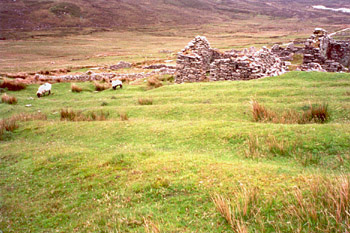By Karen-Beth G. Scholthof,
Department of Plant Pathology and Microbiology,
Texas A&M University
Phytophthora infestans, the causal agent of late blight disease on potato, is likely the most "famous" plant pathogen and continues to be of economic significant in potato growing regions around the world. Of course there is also another side to the story, a human side, that becomes so real when one explores the "famine trail."
The impact of Phytophthora infestans on Ireland in the mid-1880s forever transformed western culture as result of the deaths of at least one million poor people in Ireland and the immigration of another 1.5 million Irish to North America and Australia. Some of the history of this terrible agricultural, economic and social event can still be experienced by traveling to Ireland and Canada.
Part of the living history of the Great Famine in Ireland is found at the deserted village of Slievemore on Achill Island. This abandoned community reinforces the poverty and hardship endured by the Irish poor during the famine. There are more than a dozen ruins of stone huts that are partially or mostly intact; it appears that about 1000 people lived on the site.
 |
|
"Lazy beds" at Slievemore (Achill Island, Ireland). |
Sheep contentedly graze on the "lazy beds," the undulating pastures that barely conceal the traditional farming practice of hilling up the land to allow water to drain downhill to protect the potatoes from excess moisture and which were also surrounded with manure or seaweed to fertilize the plants. The Famine Museum <http://www.strokestownpark.ie/>, located about 60 miles west of Dublin, presents the Irish Famine from the perspective of the poor, landless peasant completely dependent on the potato, and the landlords who were forced to make hard economic decisions regarding tradeoffs between staying solvent or providing for their workers.
The Famine Trail continues across the Atlantic Ocean, where the effects of the famine on North American are revealed at the living history museums at the Grosse Ile Immigration Station <http://www.pc.gc.ca/lhn-nhs/qc/grosseile/index_e.asp >. As explained at The Famine Museum in Ireland, Major Mahon, a landowner in County Roscommon, made a decision to send his workers to Canada, then a colony of Britain. Many perished en route on what were termed "coffin ships." Grosse Ile, is a small island about 30 miles from Quebec City in the St. Lawrence River. It is a living history museum and a memorial to the more than 5,000 Irish immigrants who are buried on the Island and the physicians who died of typhus while caring for the quarantined.
 |
|
Immigrants' graves at Grosse Ile (Canada). |
immigrants Grosse Ile provides a visitor with an impression of the diseases, hardships, dehumanization, and confusion experienced by the new immigrants in the 1850s. Two additional memorials have been developed at Grosse Ile in memory of the Famine victims--a Celtic cross overlooking the St. Lawrence River and a series of glass walls inscribed with the victims' names. These destinations are both a moving and fascinating up-close view of a history that is so deeply linked to plant pathology.
The following books provide more information on the history of the Great Famine.
Andrea Barrett. Ship Fever. Vintage Press, 1996.
Cathal Póirtéir (ed.) The Great Famine. Mercier Press, 1995.
Cormac Ó Gráda. Black '47 and Beyond. Princeton University Press, 1999.
